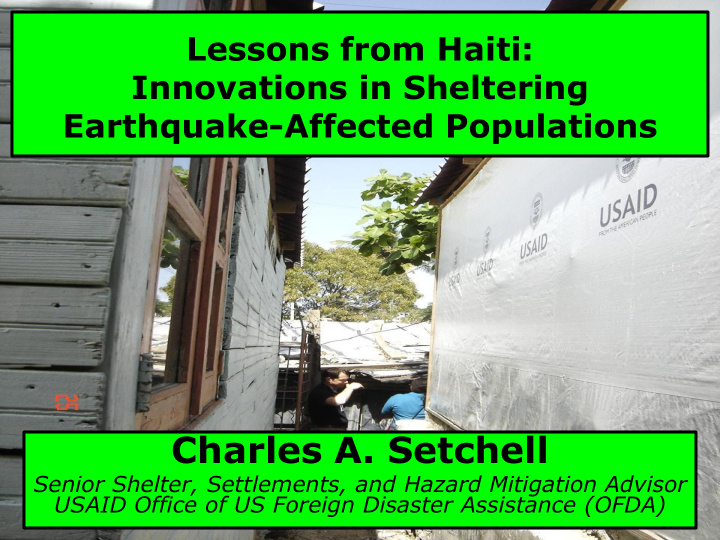



Lessons from Haiti: Innovations in Sheltering Earthquake-Affected Populations Charles A. Setchell Senior Shelter, Settlements, and Hazard Mitigation Advisor USAID Office of US Foreign Disaster Assistance (OFDA)
Shelter, the Humanitarian Counterpart to Housing, Doesn’t Exist in a Vacuum, but in… SETTLEMENTS (the Places Where People Live, from Transit Centers to Mega-Cities)
The Location, Condition, and Management of Settlements… Will largely determine whether they become the sites of future disasters -- and possible humanitarian community responses
BY NOW YOU’VE SEEN • Conditions depicted are experienced by nearly 1 of every 6 human beings • By 2030, nearly 1 of every 4!!!
S > 4W + R
Basic Q: Who “Owns” the Debris??
How Much Debris? From WP, 3-7-10
WHERE to Dispose of Minimum 1,000 Truckloads a Day for 1,000 Days??
A Critical Initial Challenge: Exchanging Bed Sheets for Plastic Sheets
USAID/OFDA “S&S” Outputs ($106.1 million, 26 percent of $404.3 million total) • Emergency Phase : -- Plastic sheeting distributed to estimated 500,000-600,000 people • Transitional Phase (as of 11-15-11) : -- Hosting Support to 26,523 Households (Approximately 70% evolving into permanent housing solutions) -- House Repairs Benefitting 7,601 HHs (living in 5,501 damaged structures) -- Transitional Shelter for 28,524 HHs -- Total of 62,648 Beneficiary HHs 32% Greater than 47,500 “Shelter Solutions” Objective (approx. $1,695 per HH)
Tracking Displacement as Clue for Assistance
Hosting Support
Hosting (“STEALTH” Shelter) Really Does Work • Primarily socially defined, based on family, friends, neighbors, etc. • Commences before humanitarians arrive on the scene, i.e., self-selected, often not seen, thus “ Stealth Shelter ” • Cost-effective, flexible means of sheltering, and • Often transitions to permanent shelter. In Haiti, 70% of OFDA hosting support apparently evolving into permanent housing solutions .
Assessing Damage to Inform Repair Programs
“TS” Not New; Rooted, in part, in “Earthquake Refugee Shacks,” San Francisco, 1906
“EQ Shack” (actually two, and raised), being upgraded (again), 2003
The Utility of Shelter Assistance to Response and Recovery • Even Modest Forms of Shelter (TS More So) jump-start and re-engage affected populations in the incremental, longer- term housing development process • Means of Promoting Livelihoods and DRR, and • Unlike other sectors, no easy handoff to development . With programmatic vacuum, all the more reason to emphasize TRANSITION and CONTEXT.
Settlements-based Activities • Macro-level: Support of GoH, UN, and NGO Agencies to Engage in “Emergency Urban Planning” • Micro-level: Support of Neighborhood-based projects
Neighborhood Approach in Concept
…To This: Multiple Shelter Solutions in Context
First-ever Two- Story “TS” Produced by “HA” Community, Reflecting Context
BEYOND THE TWO-STORY T-S AND HOOPLA OF THE “NA” EFFORT IN HAITI… • 20 percent of 18-acre site reconfigured through settlements planning process • Permitted new accessways, evacuation routes, improved drainage, etc., i.e., safer shelters and a safer settlement • This ALSO increased the area to be used for shelter, and ALSO changed market for land, making pre-event vacant land more valuable. We’re facilitating the upgrading of lots to permanent housing!
Also Beyond the Hoopla: Upgrading Side-by- Side, with “Complete” and “In Progress” Stages, Based on Re-engaging Pre-Event Processes
“TS” Upgrading to Permanence
GETTING FROM THIS…
To This NOT the Responsibility of the Humanitarian Community, but…
Re-conceiving the Road to Recovery Requires Re- conception of Core Processes • “Standard” Approach: ES + TS + PH • Some Now Promoting: ES + PH • Our Alternative: ES + (TS PH) + PH
RRR : Recognizing The Centrality of Settlements • Spatial framework provided by focus on Settlements provides the “catch - all” context for shelter interventions • This Area-Based approach changes the focus from households and shelter to neighborhoods and larger communities, and • This change in Unit of Analysis particularly useful in urban areas.
RRR : FOCUSING ON SETTLEMENTS SIDE OF SECTOR • Shelter is the Easy Part; the Much Tougher Issue is LAND • However, if Land Issue was Impossible, Nothing Would Happen, so Something’s Afoot. We Need to do Better Job of Figuring it Out Sooner • In PAP, Affected Area “lost” an estimated 30% of land area due to Rubble, making sheltering all the more difficult, and • Surgical, neighborhood-based focus preferred over “clear cut” efforts; requires creative “S&S” work (e.g., settlements planning and land readjustment)
RRR : HA Actors Can Help “Frame” the Future • Need for “framing” follow -on reconstruction is critical; this includes “emergency master planning,” as most official plans are aspirational, perhaps even inspirational, but not operational • Haiti : GoH plan for PAP assumed removal of 1.2 million people from city, based on view that it was “too big”.
RRR : URGENT NEED TO PLAN THE CONFIGURATION AND RECONFIGURATION OF RISK- PRONE SETTLEMENTS
Challenges Remain: Exchanging Plastic Sheets for Longer-term Shelter
… and the Transformation of “Pledged Funds” to “Completed Projects” Status of $5.3 B Pledged at March 2010 International Donors Conference for Recovery: • Pledges for ‘10 - ’12, as of Sept. 2012: Disbursed - 53.2%, $2.837 B (up from 45.3% in April 2012) Committed - 38.7%, $2.063 B Pending - 8.1% $432.69 M Note : This analysis does not include funds pledged for humanitarian relief activities. It is also exclusive of pledges made by privately funded organizations at the New York donors’ conference. Source : http://www.haitilibre.com/en/news-5492-haiti-reconstruction-between-pledges-and-disbursements.html
Some Final “Take - Aways”…
THANK YOU FOR YOUR TIME AND ATTENTION. QUESTIONS? CSETCHELL@USAID.GOV
Recommend
More recommend